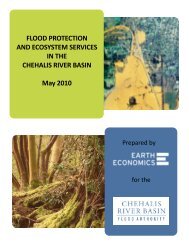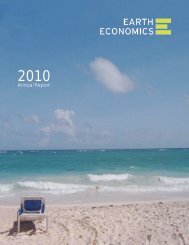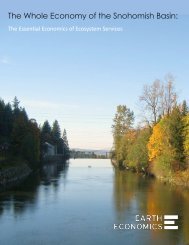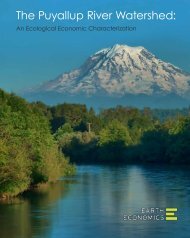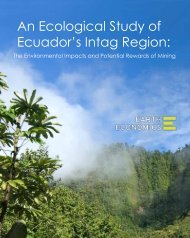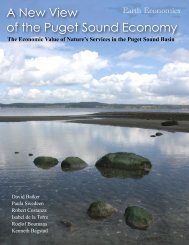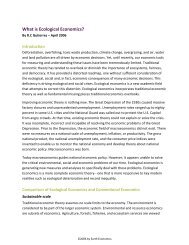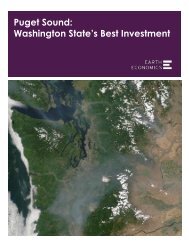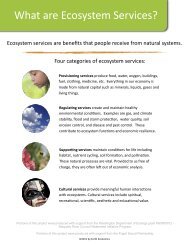The Spot Prawn Fishery: A Status Report - Earth Economics
The Spot Prawn Fishery: A Status Report - Earth Economics
The Spot Prawn Fishery: A Status Report - Earth Economics
Create successful ePaper yourself
Turn your PDF publications into a flip-book with our unique Google optimized e-Paper software.
<strong>The</strong> <strong>Spot</strong> <strong>Prawn</strong> <strong>Fishery</strong>: A <strong>Status</strong> <strong>Report</strong><br />
spot prawns in Oregon. What information exists<br />
suggests that spot prawns are abundant only in<br />
limited habitat types with little or no migration<br />
between areas. According to ODFW, the fishery’s<br />
biological potential appears finite. ODFW is concerned<br />
that, given the scale of spot prawn distribution<br />
in Oregon, localized depletions are likely, and<br />
the population is at risk due to overfishing. <strong>The</strong><br />
long-term sustainability of the fishery requires<br />
that basic biological and ecological information is<br />
acquired and reflected in management and regulatory<br />
systems. <strong>The</strong> short- and long-term effects of<br />
harvesting spot prawns on spot prawns, other<br />
marine species, and the ecosystem must be determined.<br />
According to ODFW, spot prawns should<br />
continue to be “managed under the developing<br />
fisheries program with conservative numbers of<br />
permits and landing restrictions” (McCrae 1994).<br />
<strong>The</strong> Department has identified the following areas<br />
for further inquiry:<br />
•Acquire the scientific information needed to<br />
determine the biological status, distribution,<br />
and life history of spot prawns by:<br />
1. obtaining area-specific biological samples,<br />
as well as on-board and dockside samples<br />
2. recording gear, effort, location, depth, and<br />
time data in logbooks<br />
3. analyzing existing trawl survey and commercial<br />
fishery incidental catch data<br />
•Develop an understanding of the effects of fishing<br />
on marine habitats and ecosystems and<br />
other species<br />
•Improve fishing practices and equipment to<br />
protect the ocean resources, particularly by:<br />
1. developing fishing methods that reduce<br />
the impact of trawl gear on marine habitat<br />
2. developing fishing methods that reduce<br />
incidental catch of non-target species<br />
•Identify and protect critical marine habitat<br />
and other important biological habitats for spot<br />
prawns, by identifying juvenile, spawning, and<br />
rearing areas<br />
CALIFORNIA SPOT PRAWN FISHERY<br />
Biological <strong>Status</strong> of <strong>Spot</strong> <strong>Prawn</strong>s<br />
<strong>Spot</strong> prawns in California are distributed in the Santa<br />
Barbara Channel and at the head of submarine canyons<br />
such as Monterey Canyon, its tributary Carmel<br />
Canyon, and the canyons of the Southern California<br />
Bight. <strong>Spot</strong> prawns are also associated with ocean<br />
features such as offshore banks, ridges, and islands<br />
like the Channel Islands. Exploratory biological surveys<br />
carried out by the California Department of Fish<br />
and Game (CDFG) in the 1960s revealed the presence<br />
of spot prawns coast-wide. Estimates of population<br />
size were not made at that time. Additional surveys<br />
carried out in the 1980s focused on species distribution<br />
and range.<br />
At present, few data are available regarding the status<br />
of the stock, other than that an annual harvest level<br />
exceeding 300,000 pounds has been maintained for<br />
most of the last ten years. CDFG does not have the<br />
resources to conduct biological surveys. Catch per<br />
unit of effort (CPUE) and total catch are considered<br />
by managers to be the best indicators available of<br />
resource status. <strong>The</strong>se indicators “appear to be sustainable<br />
at this time” (Paul Reilly, CDFG. Pers.<br />
comm., February 2001).<br />
History of the <strong>Fishery</strong><br />
<strong>The</strong> California spot prawn fishery has a fairly long<br />
history, beginning in the 1930s, when Monterey<br />
Bay fishers started landing spot prawns incidentally<br />
caught in octopus traps. It did not develop<br />
into a commercial-scale fishery until the 1970s.<br />
Statewide annual landings never exceeded 10,000<br />
pounds until 1974, when Santa Barbara trawlers<br />
caught more than 182,000 lbs. of spot prawns. <strong>The</strong><br />
Santa Barbara area became the focus of the spot<br />
prawn fishery, and trawl the primary gear type.<br />
By 1994, the spot prawn fishery consisted of four<br />
principal geographical components: northern<br />
California trawl, northern California trap, southern<br />
California trawl, and southern California trap.<br />
In the northern fishery (north of Morro Bay), the<br />
number of trawlers has fluctuated between 1 and<br />
27 vessels over the last 20 years; trap vessels have<br />
varied between 4 and 13. In the southern fishery,<br />
trawlers have numbered from 17 to 51, trap vessels<br />
from 1 to 66. Statewide landings nearly doubled<br />
between 1994 and 1998, reaching a historic peak<br />
of 772,900 lbs. All elements of the fishery showed<br />
significant growth: northern trawl showed a 14-<br />
fold increase, northern trap a 4-fold increase,<br />
southern trawl a 4-fold increase, and southern<br />
trap almost doubled.<br />
<strong>The</strong> rapid development of the fishery is attributable<br />
to a number of different factors, including:<br />
•increased market demand<br />
•increased fishing effort due to California and<br />
38



